It is appropriate that the first recipe for this new blog should focus on making macarons. Baking has been something that I have enjoyed for many years but a fascination for French patisserie became a passion to learn how to create some of the classics, and not so classics, after attending a short course on making macarons at Patisserie Guillemard in La Flèche, a small town close to Le Mans in France in August 2012.
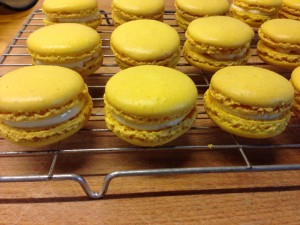
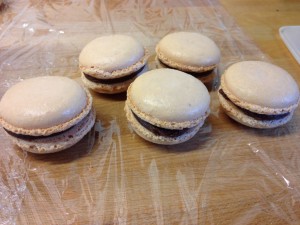
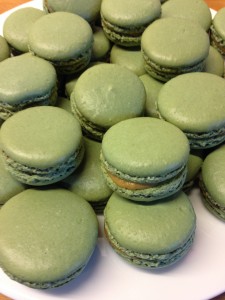
Curious about the history as well? – read on!
What is a macaron?
There are many possible answers to this question. In England during my childhood we enjoyed the occasional coconut macaroon, simple cakes that a child might learn to make. Recipes for these cakes are numerous, including one from Mrs Beeton in 1861. Mrs Beeton’s Book of Household Management of that year included recipes that she had collected from various sources so no doubt there are earlier versions available.
In France recipes for small cakes based on ground almonds are recorded from the 1550s. In 1873 Alexandre Dumas published ‘Le Grand Dictionnaire de Cuisine’ including two recipes for macarons based on ground almonds. Neither indicates any cream filling and Dumas makes no mention of colour use, garish or not.
Historians appear to agree that the origin of the word ‘macaron’ is found in Italy. Royal houses in Europe during the 16th 17th and 18th centuries saw marriages between Italian, Austrian, German French and Spanish families and along with the political treaties that often underpinned these arrangements came an exchange of cultures. Almonds were known of in Italian cooking from the second half of the 15th century. Catherine de Medici is said to have brought almond paste to France on her marriage to the Duc d’Orleans in 1533.
To really learn about the early versions of macarons in France why not visit Musee de l’Amande et du Macaron at Montmorillon in the Vienne region. If you know of a similar repository of almond based pastries in the UK please let us know so that we can add their details.
History tells us that the simple, unadorned macaron remained a royal favourite in France through to the revolution in 1789.
1830 was a notable year in French history. In July revolutionaries were again active and Louis-Phillipe, Duke of Orleans began his 18 year reign little expecting to end his days exiled to England. In that same year someone had the idea of sandwiching two almond macarons together, using jam as the filling. While still some way from the smooth cream filled biscuits we know today as French macarons the idea clearly took off, by the end of the century Pierre Desfontaines, grandson of Parisian pattisiere Louis Ernest Ladurée, began commercial production of macarons filled with ganache.
Ladurée is of course one of the best known addresses in Paris for patisserie. It is claimed that the recipe in use today is unchanged from that introduced at the start of the 20th century.
Macarons, or macaroons were apparently often served as light refreshment in 18th and 19th century Britain. Alan Davidson, in his excellent Oxford Companion to Food, advises that they were also used in cookery to provide texture and flavour in desserts and cakes. It seems that in the UK we were perhaps more adventurous than the French in terms of adapting a basic recipe in different ways. Davidson cites a cookery book of 1827 listing eight different recipes for flavoured macaroons including chocolate, vanilla and cinnamon.
Leaping forwards the early 21st century has seen macarons featured in popular films and television programmes. Pierre Hermé in Paris opened stores selling only macarons in their 21st century guise. He has successfully marketed both sweet and savoury versions and his best selling book, simply called ‘Macarons‘, includes recipes involving lemon and avocado, foie gras and chocolate or black truffles.
A quick search on the world wide web will bring you to any number of articles expressing concern that macarons are becoming so ubiquitous that their qualities are threatened. Starbucks apparently sell them and the Wall Street Journal wrote in 2010 that McDonalds were serving them at around half the price of a Parisian equivalent.
The Recipe?
Clearly the sandwich style macarons that have generated controversy in recent years involve stages in addition to recipes of the 19th century regardless of the number of ‘o’s in the title.
Mrs Beeton’s macaroon recipe isn’t too far away from that used today to create the outer biscuits of the modern macaron. Ingredients are simply sweet almonds, sugar, egg whites and wafer paper. No ground almond in those days, the first task was to blanch, skin and dry the almonds before pounding them well with a little orange flower water (usefully omitted from the list of ingredients).
Having beaten the egg whites to a ‘stiff froth’ these and the sugar are added to the almonds and the ingredients blended together. When the paste becomes soft we are advised to use a ‘biscuit syringe’ to set out the biscuits onto wafer paper at equal distances. To ensure an attractive result we can add a line of almonds to the top of each biscuit and strew some sugar over the top before baking in a slow oven until light brown in colour.
Mrs Beeton concedes that these simple biscuits require quite some work, advising that it is almost as economical to purchase them at a good confectioners.
Twelve years later in France Dumas advises that four egg whites are used with 500g almonds and the same quantity of sugar or, for a sweeter version, 1kg sugar to 500g almonds. If the mix is too dry more egg white can be used. Small portions of the mix are spread on baking paper (no indication as to what type of paper was appropriate in 1873) and baked in a well closed gentle oven.
Modern Variations
All recipes for the modern variant on a macaron involve sugar, almonds and egg white. There are broadly two schools of thought in respect of the approach to take: French meringue or Italian meringue. The former is perhaps simpler, requiring nothing more than a means to whisk the egg whites. Italian meringue turns part of the sugar to a syrup and so requires a means of heat and a thermometer.
At Patisserie Guillemard we used French meringue as the base for our macarons. This was my first attempt at making macarons and for some time after attending the course I made every effort to succeed using the method taught. The results weren’t bad, the flavour was fine but I couldn’t achieve a consistent finish. Further research brought me to Pierre Hermé’s ‘Macarons’ and the Italian meringue method.
Now things were better, predictable to the extent that I could produce macarons that I was happy to share with people. From time to time the results would be less perfect than I had hoped and I continued my research in attempt to gather as much information as I could in order to improve and achieve respectable and repeatable results.
The method I use is still basically that of Pierre Hermé. Recently though I have changed the way in which I mix the dry ingredients into the meringue. If you look on You Tube you will find hundreds of videos insisting that the art of ‘macaronage’ can only be achieved in specific circumstances: a dry room at 47.5 degrees, wind in a certain direction, two ducks walking wing in wing down the street…. Search long enough and I’m sure you will find advice at least as ludicrous.
Meanwhile French television created its own version of Great British Bake Off. Mary Berry is replaced by Mercotte, aka Jacqueline Mercorelli, a food writer and blogger in her 70s. Mercotte has an extensive blog full of recipes and where macarons are an important feature. Her books on macarons are published in English but the blog is all French. In amongst a wealth of information are some very useful hints that can make all the difference.
Mercotte also appears in several You Tube videos. In one of these I was surprised to find Mercotte advocating use of a food mixer to achieve all of the stages of preparing a macaron batter. While the Expert asserts that only a Kitchen Aid mixer will allow you to achieve good results I can assure any one interested that a ‘vintage’ Kenwood Chef is just as reliable. This has been my preferred method for some short while now and it is on that basis that I offer the recipe below.
This recipe is a basic macaron mix. Save for any colouring, the recipe is identical for all classic Parisian macarons. This interpretation is based on Pierre Hermé’s recipe with minor adaptations to ingredients and method taken from the excellent ‘C’est ma Fournée‘ blog and Mercotte.
The mix should give you around 35 complete macarons.
You will find a recipe for chocolate ganache here (to follow soon)
Ingredients
Equipment (in addition to the obvious bowls, spatulas etc)
ESSENTIAL
DESIRABLE
Preliminary Steps
Weigh out all of the ingredients so that everything is to hand when you get started.
Prepare a piping bag ready for the macaron mixture
Prepare baking sheets by covering with baking parchment.
If you are not an expert with a piping bag, prepare a template to slide under the baking parchment, this should have rows of circles 3cm wide, spaced 2cm apart to allow the shells to spread without sticking together. This won’t come into contact with the mix and so can be stored and used again.
If using a template place this under the baking parchment
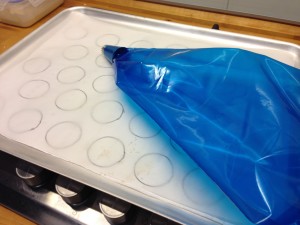
1. Place ground almonds and icing sugar into the bowl of a food processor fitted with the knife blade. Process until the two powders are well mixed. This avoids the need to sieve ground almonds and creates a ‘want pour tant’, an equal mix of the two ingredients.
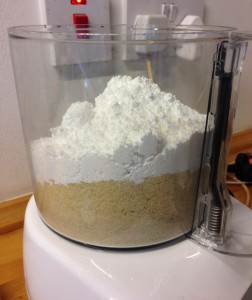
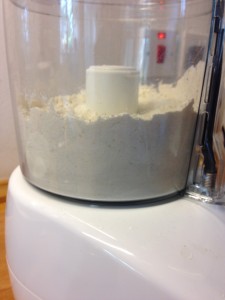
2. Place water and caster sugar in a small pan, heat to form syrup and continue cooking until the syrup reaches 118°c
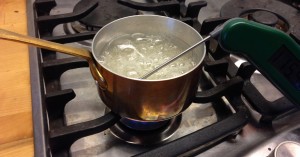
3. When the syrup reaches 110°c begin whisking one of the portions of egg white in a stand mixer. You can of course do this by hand but any type of mixer will make the task much easier. We have a small Dualit hand mixer that performs tasks such as this with ease. As the egg whites begin to stiffen add the 15g caster sugar in three portions. Whisk until egg whites form stiff peaks.
4. With the mixer at a medium speed pour the syrup onto the egg whites and mix until it is incorporated. The egg whites should regain stiff peaks.
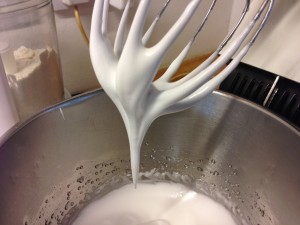
Remove the whisk from the stand mixer and insert the flat (K) beater. If you have used a hand mixer or whisk to this stage, use a silicone spatula for step 5. Most recipes advise use of a spatula at this point, it was only after finding Mercotte’s version that I began using a stand mixer throughout. The task can be achieved just as easily by hand.
5. Tip the remaining egg whites and the tant pour tant into the mixer and beat until the powders are incorporated into the egg whites. This should take less than a minute. Either continue beating with the mixer until the texture of the mix forms a ‘ribbon’ when dropped from a spatula, or complete this stage by hand with a spatula. Again, if completed in the mixer this stage takes only a few seconds.
A huge amount has been written about finalising the macaron paste and you will find any number of videos on You Tube showing the consistency to aim for. The more the paste is mixed the thinner it will become because air will be knocked out of the meringue that holds the paste together. A mix that is too stiff will be difficult to pipe into smooth discs. It really is a question of trial and error, certainly it is easier to work with a slightly thicker paste and for a first attempt it is probably best to go in this direction.
Watch this space for photographs showing the consistency of the mix I use….
6. Transfer the mixture to the piping bag, use a spatula or similar to force all of the mixture towards the tip of the piping bag so that you can twist the top and manage the paste as you pipe the discs.
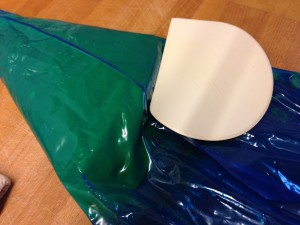
7. With the tip of the piping bag almost touching the baking parchment pipe out macaron halves to form 3cm discs. This task really is made much easier if you have a template beneath your sheet of baking parchment.
Keep the bag upright and resist any temptation to lift the tip away from the paper or to form a swirl or similar to finish each disk. Simply pull the bag away when the disk is large enough. The aim is to achieve a flat surface and this is only made more difficult if the bag is too high when the mixture is piped or if you attempt to add an artistic swirl!
Any small peaks should settle by themselves as the macarons will stand for 15 minutes before baking. Larger bumps can be flattened with a damp finger or pastry brush but if you pipe the shells as described you shouldn’t need to spend time attempting to squash peaks down.
As with many things it can take a while to achieve the desired results. Remember that whatever their appearance your macarons will be edible and it is all but certain that you, your family and friends will enjoy every tray that you bake.
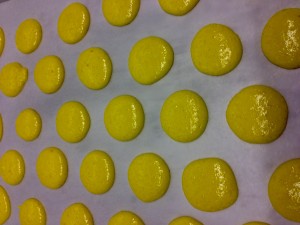
This tray was made using a mix that was relatively liquid, while there are no ‘points’ on the top of the discs there are quite a few ‘mishaps’… The garish yellow colour tones down considerably when cooked.
8. Leave the trays of macarons to dry at room temperature for around 15 minutes. After that time if you gently touch the top of one you should feel that a very slight crust has formed.
During this time pre-heat the oven to 160°c.
All ovens are different. Experimentation has shown that if I bake my macarons at 160°c for 15 minutes they are just right. Your oven might be faster or slower and the only way to find the right temperature is to try it out. Mercotte asserts that it is impossible to make macarons in a gas oven. I haven’t tried but given that she also says that it is impossible to make macarons with any mixer other than a Kitchen Aid and I have found my 40 odd year old Kenwood Chef more than appropriate I wouldn’t take her word on ovens too seriously.
9. Bake each tray of macarons for 15 minutes. If your oven has a glass door you should be able to watch as each little disk gradually forms a little collar at its base while the top remains smooth. Once out of the oven slide the parchment off the hot tray and leave the macarons to cool a little. After about ten minutes they should lift easily from the parchment.
Attempting to lift the macarons from the parchment while they are still warm is a mistake often made. It really is better to wait until they are quite cool when they will detach much more easily. If you really can’t wait you might find that a spatula helps move macarons that are still warm.
If you have followed this recipe you should have approximately 70 single macaron biscuits. Fillings can be as simple or sophisticated as you wish. Chocolate is always popular, pistachio and bitter almond also go well with the sweetness of the macaron shells. We will publish various filling recipes as we go along, for now you might enjoy this toffee apple variety.
Macarons store well in a sealed box kept in the refrigerator. You can store them filled or as they are.
Eggs
Much has been written about egg whites suitable for macarons. Some experts would have you stand the egg whites at room temperature for days in order to evaporate water content, others state that the older the egg whites the better.
Frankly I have used fresh, less fresh and extremely unfresh egg whites for macarons and have found no difference in the results. I would advise that the egg whites, in fact all ingredients, should be at room temperature when used.
Many supermarkets now sell pasteurised free range egg whites in tetra packs. These are fine for macaron making if you won’t have a use for egg yolks.
Baking Parchment
Perhaps you have seen silicone mats marked out for macaron baking and think that these will be better than simple parchment. Experience has taught me that while silicone can be very useful in the kitchen, it can also cause problems. This is especially the case when baking and we will write more on the topic, and the reasons to think carefully before spending large amounts of money on pretty accessories that don’t perform as hoped.
To achieve well baked macarons with regular collars simple baking parchment is much the best option in my experience.